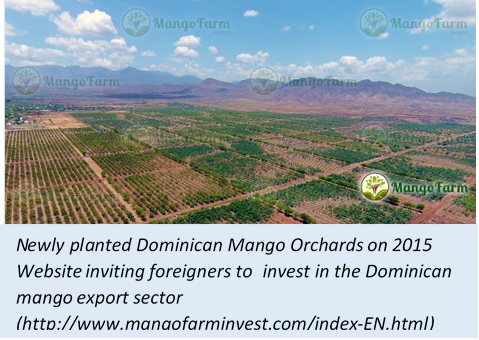While Haiti absorbed some US $120 million of investments in the mango sector and did not significantly increase mango exports, the Dominican Republic created a mango export industry. In 1989 they only had 1,250 hectares planted in orchards. By 2006 that figure had tripled to 4,400 hectares. As for exports, they went from 8,222 boxes in 1999 worth US $25,000 to some 1.5 million boxes in 2007 worth US$7 million to 2.5 million boxes this year, 2015, worth $17 million.
The Dominicans export Francique mangos. But they also export Keitt, Kent, Palmer, Tommy Atkins, and Haden mangos. They all go to the ethnic, gourmet and organic market. In 2008 there were already five Dominican companies making mango juice and others making chutneys, jellies and jams. Indeed, the only mango juice company in Haiti operates under the Dominican brand Famosa.
As for the mango exports, unlike Haiti, the US market has only a little to do with this success. Europe receives 70% of Dominican exports where the main clients, in order of importance, are the U.K, Netherlands, Germany, Canada, Spain, Belgium, France, Italy, Austria, Ukraine, Martinique, Poland, and Switzerland. The Dominican Republic even exports to Japan. And they export to other Caribbean islands, such as Guadeloupe, San Martin, Martinque and the Turks and Caicos (the USA is the third largest recipient of Dominican mango).
It is unlikely that Haiti will be able to keep up with the Dominicans, who in contrast to Haiti where the landscape is saturated with small peasant producers, have vast tracks of empty agricultural land available at much lower prices and with greater legal protection regarding land tenure. But more worrisome is that they may just knock the Haitian out of the market altogether. The Dominican mango industry is growing at a steady 15% per year. Last year they caught up to Haiti at 2.5 million boxes of mangoes. In the next 10 years they expect to hit 25 million (Dominican Today 2015; EFE 2014). With maturing orchards of Francique mangos and recent purchases of heat tanks to meet USDA requirements for mangos, the Dominicans have their set their sights on further expansion in the US market as well.
(for references and more data see here)
For other works on the Border and/or Dominican Haitian relations, see these posts:
DOMINICAN REPUBLIC: THE HAITIAN-DOMINICAN BORDER: MISUNDERSTANDINGS
DOMINICAN REPUBLIC: WHERE DID ALL THE GIRLS GO? RURAL DOMINICAN SEX RATIOS
DOMINICAN REPUBLIC: JUSTICE SYSTEM IN THE DOMINICAN REPUBLIC
DOMINICAN REPUBLIC: AN OPEN CRITIQUE OF JARED DIAMOND’S COLLAPSE (HAITI AND DR)








